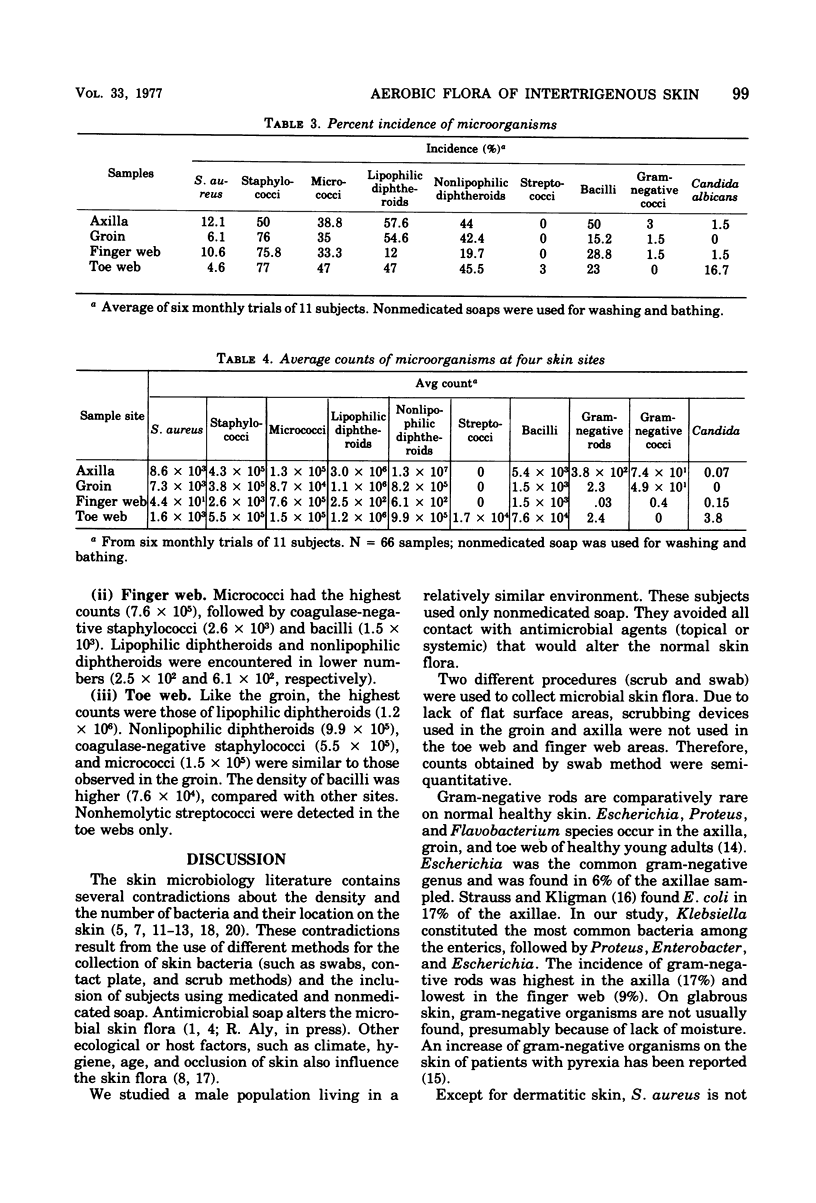Abstract
The incidence and density of intertrigenous microflora were determined in subjects using nonmedicated soap. The axilla, groin, toe web, and finger web were examined. The incidence of gram-negative rods was 17% for the axilla, 13% for the groin, 10% for the toe web, and 9% for the finger web. Klebsiella, Proteus, and Enterobacter were the predominant organisms, in that order. The highest incidence of Staphylococcus aureus was in the groin (12%) and toe web (11%). Lipophilic diphtheroids were the most prevalent bacteria in the groin (1.1 X 10(6)/cm2) and toe web (1.2 X 10(6)/cm2). Nonlipophilic diphtheroids were the predominant flora in the axilla (1.3 X 10(7)/cm. Micrococci had the highest counts in the toe web (7.6 X 10(5)/cm2). The incidence of coagulase-negative staphylococci was highest in the finger web, but the major flora were those of micrococci.
Full text
PDF



Selected References
These references are in PubMed. This may not be the complete list of references from this article.
- Aly R., Maibach H. I. Effect of antimicrobial soap containing chlorhexidine on the microbial flora of skin. Appl Environ Microbiol. 1976 Jun;31(6):931–935. doi: 10.1128/aem.31.6.931-935.1976. [DOI] [PMC free article] [PubMed] [Google Scholar]
- Forfar J. O., Gould J. C., Maccabe A. F. Effect of hexachlorophane on incidence of staphylococcal and gram-negative infection in the newborn. Lancet. 1968 Jul 27;2(7561):177–179. doi: 10.1016/s0140-6736(68)92618-4. [DOI] [PubMed] [Google Scholar]
- KLIGMAN A. M., STRAUSS J. S. The bacteria responsible for apocrine odor. J Invest Dermatol. 1956 Aug;27(2):67–71. doi: 10.1038/jid.1956.79. [DOI] [PubMed] [Google Scholar]
- Leyden J. J., Marples R. R., Kligman A. M. Staphylococcus aureus in the lesions of atopic dermatitis. Br J Dermatol. 1974 May;90(5):525–530. doi: 10.1111/j.1365-2133.1974.tb06447.x. [DOI] [PubMed] [Google Scholar]
- Noble W. C. Skin carriage of the Micrococcaceae. J Clin Pathol. 1969 May;22(3):249–253. doi: 10.1136/jcp.22.3.249. [DOI] [PMC free article] [PubMed] [Google Scholar]
- Somerville D. A., Noble W. C. A note on the gram negative bacilli of human skin. Rev Eur Etud Clin Biol. 1970 Jun-Jul;15(6):669–671. [PubMed] [Google Scholar]
- Somerville D. A. The normal flora of the skin in different age groups. Br J Dermatol. 1969 Apr;81(4):248–258. doi: 10.1111/j.1365-2133.1969.tb13976.x. [DOI] [PubMed] [Google Scholar]
- Stratford B., Gallus A. S., Matthiesson A. M., Dixson S. Alteration of superficial bacterial flora in severely ill patients. Lancet. 1968 Jan 13;1(7533):68–68. doi: 10.1016/s0140-6736(68)90068-8. [DOI] [PubMed] [Google Scholar]
- Taplin D., Lansdell L., Allen A. M., Rodriguez R., Cortes A. Prevalence of streptococcal pyoderma in relation to climate and hygiene. Lancet. 1973 Mar 10;1(7802):501–503. doi: 10.1016/s0140-6736(73)90324-3. [DOI] [PubMed] [Google Scholar]
- Voss J. G. Effects of an antibacterial soap on the ecology of aerobic bacterial flora of human skin. Appl Microbiol. 1975 Oct;30(4):551–556. doi: 10.1128/am.30.4.551-556.1975. [DOI] [PMC free article] [PubMed] [Google Scholar]
- Williamson P., Kligman A. M. A new method for the quantitative investigation of cutaneous bacteria. J Invest Dermatol. 1965 Dec;45(6):498–503. doi: 10.1038/jid.1965.164. [DOI] [PubMed] [Google Scholar]


